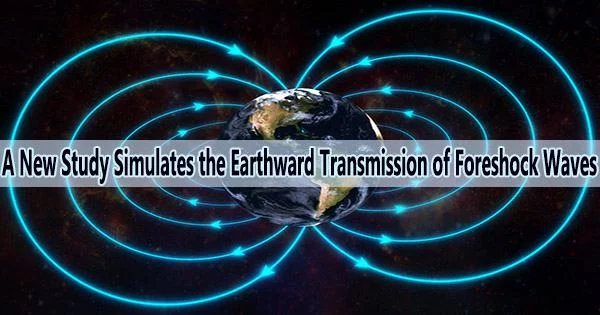A new study has modeled the transmission of foreshock waves towards Earth to better understand the behavior of earthquakes and improve earthquake forecasting. The study aimed to identify patterns in the transmission of these waves, which can provide valuable information to seismic networks and help predict when a larger earthquake may occur.
An international team of scientists led by Lucile Turc, an Academy Research Fellow at the University of Helsinki and supported by the International Space Science Institute in Bern has studied the propagation of electromagnetic waves in near-Earth space for three years.
The group has investigated the waves in the foreshock zone, which is where the solar wind and Earth’s magnetic field contact, as well as how the waves are transmitted to the opposite side of the shock. The results of the study are now published in Nature Physics.
“How the waves would survive passing through the shock has remained a mystery since the waves were first discovered in the 1970s. No evidence of those waves has ever been found on the other side of the shock,” says Turc.
The team has reconstructed and comprehended the physical processes behind wave transmission using the cutting-edge computer model Vlasiator, which was created at the University of Helsinki by a team under the direction of professor Minna Palmroth.
A detailed examination of the simulation indicated the existence of waves with nearly identical characteristics to those of the foreshock on the opposite side of the shock.
Eventually, it became clear that things were much more complicated than it seemed. The waves we saw behind the shock were not the same as those in the foreshock, but new waves created at the shock by the periodic impact of foreshock waves.
Lucile Turc
“Once it was known what and where to look for, clear signatures of the waves were found in satellite data, confirming the numerical results,” says Lucile Turc.
The waves in the foreshock can enter the Earth’s magnetic field
The magnetosphere, a magnetic bubble surrounding our planet, protects us from the solar wind, a stream of charged particles emanating from the Sun. Scientific observatories in space and on the ground routinely record electromagnetic waves, which appear as minute fluctuations of the Earth’s magnetic field. These waves may originate from outside the magnetosphere or may be brought about by the action of the shifting solar wind.
Because they may accelerate particles to high energy, which can harm spacecraft electronics and cause these particles to fall into the atmosphere, electromagnetic waves play a significant role in the formation of bad space weather around our planet.
Scientific observatories frequently record oscillations at the same period as those waves that arise ahead of the Earth’s magnetosphere, playing a distinct magnetic song in a region of space known as the foreshock on the side of Earth facing the Sun.
The waves in the foreshock can enter the Earth’s magnetosphere and travel all the way to the Earth’s surface, leading space scientists to believe that there is a relationship between the two. One significant roadblock stands in their way, though: the waves must pass through the shock to get to the magnetosphere.
“At first, we thought that the initial theory proposed in the 1970s was correct: the waves could cross the shock unchanged. But there was an inconsistency in the wave properties that this theory could not reconcile, so we investigated further,” says Turc.
“Eventually, it became clear that things were much more complicated than it seemed. The waves we saw behind the shock were not the same as those in the foreshock, but new waves created at the shock by the periodic impact of foreshock waves.”
When the solar wind flows through the shock, it is compressed and heated. The amount of compression and heating depends on the shock strength. When wave crests or troughs hit the shock, Turc and her colleagues demonstrated that foreshock waves can adjust the shock, making it alternately stronger or weaker.
As a result, in tandem with the foreshock waves, the solar wind behind the shock alters regularly and produces fresh waves.
The computer model further clarified that the turbulence in this area might readily obscure these waves, which could only be seen in a limited area behind the shock. This most likely explains why they hadn’t previously been seen.
Although the waves from the foreshock only have a small impact on Earth’s space weather, they are crucial to comprehending the basic mechanics of our world. By better understanding the characteristics of foreshock waves, the researchers hope to improve our ability to anticipate and prepare for earthquakes.
















